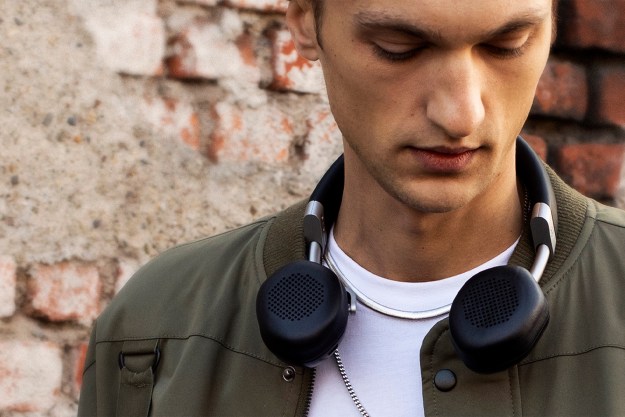
- Gorgeous wood-grain aesthetic
- EarPrint technology builds personalized stereo equalizer
- Useful app lets you switch seamlessly between EarPrints
- Works in both Bluetooth and wired configurations
- Warm, balanced sound signature
- On-ear design limits noise isolation somewhat
- Vocals can sound a bit echoey
“Why do we have prescription lenses for our eyes, but not for our ears?” This is the question that prompted Danny Aranson to found Even Headphones, a company focused on creating a personalized listening experience. Because not all ears are made equal (and because hearing, like eyesight, changes drastically over time), the Even team built the EarPrint system, which analyzes the wearer’s hearing to create a unique equalizer based upon each ear’s response to tones of differing volumes and frequencies. The latest from the brand are the H2 wireless on-ear headphones. Our Even Headphones H2 review sets out to decide whether EarPrint is a flash in the pan, or a legitimate game changer.
Out of the box
At first glance, you might think Even hails from Pittsburgh (it’s actually based out of Israel, with two U.S. offices). The box is mostly black except for a Steelers-yellow front panel, featuring an image of the headphones and some branding.
One side of the packaging lists all of the H2’s specs and features, while the other side shows a circular frequency chart representative of the EarPrint system. Inside, the cans are tucked in a hard carrying case bearing the sleek symmetry of Even’s logo. Accessories include just a durable MicroUSB charging cable and a 3.5mm headphone cable for wired use when the battery runs out.
Features and design
The H2 themselves are handsomely designed (especially for wireless cans), featuring a wood-grain finish from genuine walnut on the back of the earcups opposite sweat-resistant leatherette in black. The same leatherette also coats the band, atop which you’ll see Even’s logo inscribed.
The segments connecting the band with the earcups are aluminum, coated in brushed chrome. The headphones feel resilient in your hands (especially the adjustable parts), and fold up neatly to fit within the case.
The H2 are comfortable, especially for on-ear cans. The H1 were worn over the ear, and the shift is accompanied by a slight downgrade in noise isolation, but Aranson assures us that the change was made in response to customer feedback.
In our experience, the H2 are better suited for quiet environments; in addition to middling isolation, the H2 don’t fit very snugly, which makes for a more comfortable headphone but also means they can easily be jostled out of place on a train ride or while walking. It would have been nice to see the H2 get aptX support for improved Bluetooth streaming from compatible devices like Android phones (or more color choices), but that’s not such a big deal.
All four control buttons – play/pause, volume keys, and the Even button, which controls power and EarPrint activation – are located on the right earcup, alongside the 3.5mm jack. If the H2 run out of juice, you can just wire into your phone and keep listening (though the EarPrint system won’t work). The left cup is where you’ll plug in for charging.
Setup
To find that perfect fit, the H2’s EarPrint system runs an audio diagnostic test of sorts – an “audiogram” –which uses a proprietary algorithm to figure out which frequencies your ears hear best and tailor playback accordingly.
After charging up your cans, you’ll want to set up your EarPrint before pairing the H2 to your preferred device. It’s vital that you find a quiet space for this step, and you’ll want to make sure the headphones fit as snugly as possible to eliminate outside noise.
The difference with EarPrint is remarkable.
Double tapping the Even button will initiate EarPrint, at which point a friendly female voice named Sarah will guide you through the process, which is quite simple. She’ll play a series of musical compositions – eight in your left ear, then the same eight in your right – which represent a variety of frequencies between 125hZ and 14kHz.
All you need to do is press the Even button as soon as you hear music playing. Sixteen button presses (and several verbal encouragements from Sarah) later, your EarPrint is all set up. Once you’ve paired the H2 (“Yes!” says Sarah) and begun listening, one tap of the Even button will activate or deactivate EarPrint, so it’s easy to hear the difference.
The EarPrint impact
To get a better idea of the philosophy behind the H2, Digital Trends spoke with Aranson at length. “The most important musical instrument you have is your hearing,” he said, “People’s hearing is unique and asymmetrical … not a ‘one size fits all’ proposition.”
And the difference between the sound with EarPrint engaged or disengaged is remarkable. The H2 sound pretty great with EarPrint disabled, but they sound really great after turning it on. Without EarPrint, the H2’s sound signature is balanced, but rather ordinary. They can handle high volume without distortion, but they don’t quite compete with other top choices at their $300 price point.
After turning on EarPrint, though, the sound became decidedly richer and deeper, improving bass response and expertly tuning effects across the soundstage.
The 40-millimeter beryllium drivers work hard to balance powerful bass with clear, bright treble, and even cranking up the volume doesn’t seem to diminish sound quality or strain the headphones. Minimalistic, synth-driven tunes like Louis the Child’s Body Gold (remix) and dvsn’s Hallucinations are entrancing, with warm, deep bass that you can almost feel in your soul.
Turn to guitar-powered cuts like Arctic Monkeys’ Do I Wanna Know and the Red Hot Chili Peppers’ Scar Tissue and notes attack with satisfying substance. Meanwhile, the gorgeous, dripping electronic marimba employed on Luca Lush’s Hold On, We’re Going Home made us feel like we were slipping into a dream (a good one).
We did notice that little details in busy compositions like Madeon’s Pop Culture tended to disappear behind the oomph of the bass, and it was not uncommon to hear vocals sound echoey, especially in lower resolution music. This wasn’t an issue with taking phone calls or listening to podcasts, though.
Speaking of podcasts, they too sound better with EarPrint engaged, as do movies (and video games as well); the headphones seem to enhance all of the audible frequencies, making them clearer and more present. In addition, digital equalizers will work on top of EarPrint, so you can customize your listening experience even further.
An app that’s actually useful
Plenty of headphones and speakers are accompanied by dedicated mobile apps these days, and far too often these apps feel tacked on, without much real purpose. The Even EarPrint app – for iOS and Android — is not one of those apps.
Open the app, and – assuming your H2 are turned on and paired – you’ll see a graph of sorts, comprising a series of concentric circles and dotted with little yellow markers meant to represent different audio frequencies.
Tap on one of the markers and you’ll be presented with a quick explanation of that frequency range, complete with examples of instruments which are best featured there. This is a really cool feature for non-audiophiles who want to know a bit more about the EarPrint’s function, as well as the sound being played.
The app also offers the ability to switch between different EarPrint customizations almost instantaneously, which is extremely useful. Want to set different EQs for the bus and for the office? Easy enough. Want to set one for yourself and one for your grandpa? Done. Switching between EarPrints is a great way to illustrate how differently people hear – even from one ear to the next.
EarPrint is bigger than Even
It’s clear that building the EarPrint system was a labor of love for Danny and the rest of the Even team, including co-founder Ofer Raz. “The median age of audiophiles is over 50,” mused Aranson. “Those people deserve and expect better than cookie-cutter audio.” Most people don’t begin wearing hearing aids until their late 60s or 70s, well past the point at which hearing loss begins to occur.
Audiophiles deserve and expect better than cookie-cutter audio.
Aranson believes the price of these devices and the stigma attached to hearing loss is a problem. He wants to spark a wider conversation about the importance of tailored audio and to help music lovers see the importance of treating your ears with care.
A key piece of Even’s vision for the future is the adaptability of EarPrint. Although Even only manufactures headphones, he sees potential for EarPrint to make its way into more devices, from speakers to car stereos. Aranson preferred not to discuss particulars, but he alluded to possible partnerships between Even and other big industry names, and promised that news would arrive by the end of 2017. Stay tuned to Even’s blog for updates.
Our Take
On their own, the H2 are good headphones – not spectacular, but solid and well-made, with good battery life and a reliable Bluetooth connection.
With the addition of EarPrint, though, Even’s flagship headphones become something else entirely. Not only do they sound great, they adapt to your ears, so they sound great for everyone. Can you find
Is there a better alternative?
It just depends what you’re looking for. Need better cover from ambient noise? Try Sony’s MDR-1000X noise cancelling
How long will it last?
Physically speaking, the H2 feel durable and reliable and the Bluetooth connection means you won’t have to worry much about fraying cables. The EarPrint technology should give the H2 a long lifespan, as you can continually tailor the sound to fit your ears, even as your hearing changes with age. Treat them right, and the H2 could last a very long time.
Should you buy it?
Yes. The H1 were quality headphones, and the H2 are an improvement in pretty much every relevant area. The EarPrint impact won’t be drastic for everyone, but it’s a unique, useful system that’ll help you get more value out of the
Editors' Recommendations
- Sony’s ULT Power Sound headphones and speakers go big on powerful bass
- The best wireless headphones for 2024 from Bose, Sony, 1More and more
- JBL upgrades its 2024 wireless headphones with massive battery life
- Audio-Technica’s $2,700 wooden wireless headphones do something no other headphones can do
- What is Bluetooth multipoint and why your next earbuds or headphones should have it













